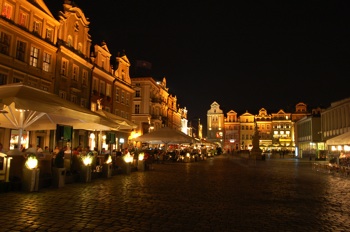
Visitors are drawn to Poznań for its rich history, vibrant cultural scene, and unique attractions, including the historic Old Town, the iconic Town Hall Goats, picturesque Lake Malta, and the delightful culinary experience of the Poznań Croissant. Poznań is also the largest center for trade fairs and exhibitions in Poland.
Historical Significance: Poznań is considered the birthplace of the Polish nation, and its historic Old Town features well-preserved architecture, including the iconic Poznań Cathedral and the Town Hall.
Goats on Town Hall: The Poznań Town Hall is renowned for its two mechanical goats, which butt heads daily at noon. This tradition, known as the Poznań Goats (Koziołki Poznańskie), is a quirky and beloved attraction.
Lake Malta: Poznań is home to Lake Malta, an artificial lake formed on the Cybina River. Lake Malta offers recreational activities, including rowing, sailing, and the popular Malta International Regatta.
Palm House: The Palm House in Poznań is one of the largest glasshouses in Europe. It houses a diverse collection of tropical and subtropical plants, providing a unique botanical experience.
Cultural Events: The city is a vibrant cultural hub, hosting numerous events and festivals, including the Malta Festival, which combines theater, music, and visual arts. Poznań also hosts the International Henryk Wieniawski Violin Competition, one of the most prestigious violin competitions globally.
Poznań Croissant (Rogal Poznański): The Poznań Croissant is a regional pastry specialty, recognized as a Protected Geographical Indication by the European Union. It is a delicious crescent-shaped pastry filled with almond paste and poppy seeds.
International Trade Fairs: The Poznań International Fair (MTP) is one of the oldest and largest trade fair complexes in the world, hosting events that attract businesses and visitors globally.
Events – Festivals
You should not miss an event that takes place usually in late June and early July – annual Malta theatre festival which takes place at many city venues. It hosts mainly modern experimental off-theatre performances, often taking place in squares and other public spaces. You can also count on cinema, visual, music and dancing events.
History of Poznan
Long before the Christianization of Poland, Poznan was an important cultural and political centre. The first historically recorded monarch of Poland – Mieszko I, located his main headquarters here. The Archcathedral Basilica of St. Peter and St. Paul, is the oldest Polish cathedral. The first Polish king – Boleslaus the Brave, was crowned there in 1025. In 1253 the city of Poznan received its founding charter under Magdeburg Law.
Poznan has been an important trade centre since the Middle Ages – starting in the 19th century, local heavy industry began to grow. Nowadays Poznan is one of the major trade centers in Poland. Poznan is said to be the second most prosperous city in Poland after Warsaw – many Western European companies have established their Polish headquarters in Poznan.
The city can be proud of many historic buildings and sights, most of them concentrated around the Old Town and other parts of the city centre. Many of these you will find on the Royal-Imperial Route – a tourist walk which leads through the most important parts of the city showing its history, culture and identity. You should definitely take a closer look at: Church of St. John of Jerusalem Outside the Walls, Bishop Jordan Bridge, Church of St. Casimir and the monastery of the Reformers, Former Philippine Monastery, Church of the Sacred Heart of Jesus and St. Florian, City Hall holding the Museum of the History of Poznan, Archbishop’s Palace, Cathedral of St. Peter and St. Paul and Rachinski Library. Check the Wikitravel notes for details.
If you are a shopaholic then your destination will be recently rebuilt The Old Browar – a shopping center raised in former brewery that contains many high-end shops and is considered one of the best in Europe. Another notable shopping centre in the city is the Malta mall, said to be one of the largest in Central Europe.
Many thanks for use of photo to https://www.flickr.com/photos/friarsbalsam/4871165876/
